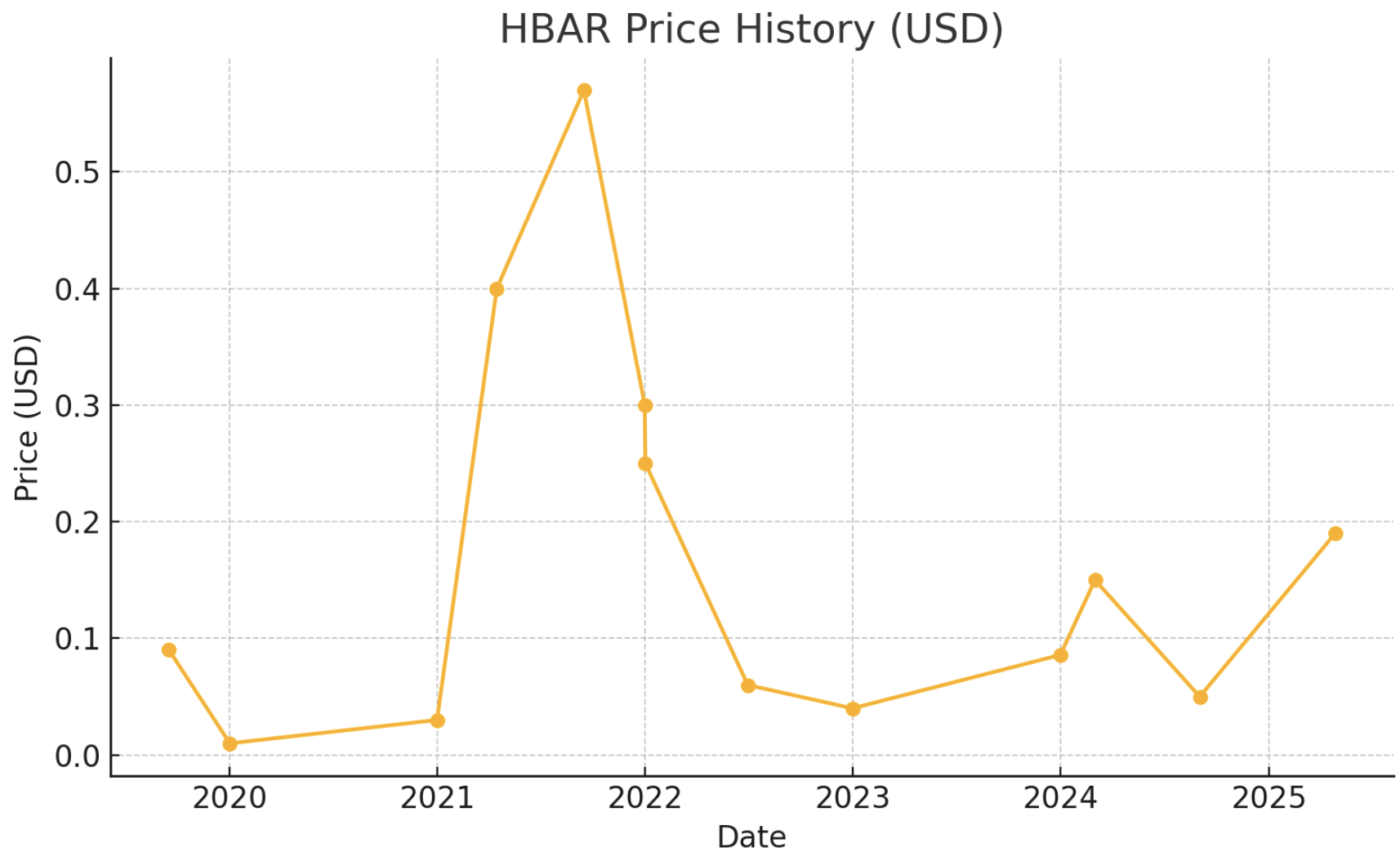Hedera Hashgraph (HBAR):创始人、技术及2030年价格展望
Hedera Hashgraph(HBAR)是一种下一代分布式账本平台,以其独特的Hashgraph共识和企业级治理而闻名。得到领先的全球公司支持,旨在为快速、安全和高效的去中心化应用提供动力。Hedera Hashgraph (HBARHedera()是一种创新的分布式账本平台,因其独特的区块链技术方法和企业主导的治理模式而受到关注。Hedera由经验丰富的科技企业家创立,并得到一些世界领先的企业的支持,旨在为去中心化应用程序提供快速、安全和公平的基础设施。自2019年公开推出以来,该平台已经实现了一些显著的里程碑——从处理数十亿笔交易到构建多样化的应用生态系统。在下文中,我们将探讨Hedera的创立故事和团队、支撑网络的Hashgraph技术、其HBAR加密货币的效用和经济学、以及与主要里程碑相关的历史价格表现,以及HBAR在短期(2025年)和长期(2030年)的价格预测。
创始故事和团队
2018年,Hedera Hashgraph由Leemon Baird博士和联合创始人共同创立曼斯·哈蒙两位技术企业家怀揣着克服传统区块链限制的愿景。巴德博士,一位计算机科学家和前教授,在2010年代中期发明了Hashgraph共识算法。与曾在美国空军和网络安全领域积累经验的技术高管曼斯·哈蒙一起,他们着手创建一个能够提供企业级性能和安全性的公共分布式账本。该项目于2018年通过融资轮次(一次引人瞩目的首次代币发行)筹集了约1亿美元,展示出投资者对其潜力的坚定信心。Hedera治理委员会成立的目的是指导网络的治理和增长。这个理事会是加密货币领域中前所未有的模式:它由多达39家来自不同行业的领先组织组成,每家组织运行一个网络节点,并在决策中拥有平等的投票权。多年来,著名的理事会成员包括谷歌、IBM、波音、德国电信、标准银行、野村等全球巨头。理事会的结构确保没有任何单一实体可以控制网络,符合 Hedera 通过广泛的、有期限的成员资格实现去中心化的目标。在 Baird 和 Harmon 的领导下——还有一个日益壮大的高管团队——Hedera 在2019年9月推出了其主网。该平台总部设在德克萨斯州,但其治理通过理事会成员在全球范围内分布。这个强大的创始团队和治理框架为 Hedera 雄心勃勃的目标打下了基础:成为互联网的信任层,服务于初创公司和企业。
Hashgraph 技术概述
Hedera的核心是哈希图与比特币或以太坊使用的区块链根本不同的一种新型共识机制。Hedera的网络节点不是将交易区块连接在一起,而是利用“关于消息传递的流言”协议来共享信息。在实践中,每个节点会随机地向其他节点传递(传播)交易和网络事件,并在每条消息中附上其通信历史的简要概述(流言)。这种巧妙的技术构建了一个交易的有向无环图(DAG),而不是单个的顺序区块链。通过使用这个信息图,网络能够通过虚拟投票实现共识,而无需矿工或耗能的工作量证明。结果是极高的吞吐量和快速的最终性:Hedera能够处理每秒数千笔交易, 确认通常在秒Hashgraph算法也是异步拜占庭容错 (aBFT),这意味着即使一些节点是恶意的或宕机,它也可以安全地达成共识,并且保证了共识的最终性,没有分叉的机会。
Hedera的技术强调速度、安全性和公平性公正性由共识机制确保——因为交易顺序是由分布式时间戳而不是单个矿工决定的,所以没有一个参与者可以操纵交易的顺序或包含。网络的设计也引以为傲能源效率. Hedera在一种变种的权益证明上运行,不需要大量计算,使其具有极高的能效;实际上,该平台是负碳,因为其能源利用最小,并通过积分抵消。这种低能源足迹,加上交易费用平均为不到一美分的一小部分(约0.0001美元)Hedera的吸引力在于,Hashgraph算法最初是专利的(由联合创始人的公司拥有),这使得Hedera成为像微支付或高容量数据记录这样的应用的一个有吸引力的选择,在其他公共分类帐上,这些应用将成本过高。Swirlds)以保护网络免受分叉的影响。走向开放的重大举措之一是,哈达拉(Hedera)理事会于2022年投票决定以Apache 2.0许可证开源Hashgraph技术,并于2023年至2024年将源代码贡献给Linux基金会。这一开源举措使更广泛的社区能够审查并信任代码库,与此同时,哈达拉仍然保持单一统一的公共网络。总的来说,Hashgraph技术使哈达拉在加密空间中拥有独特的地位:它提供具有类似区块链功能的能力,但实际上并非区块链,旨在通过不同的架构解决区块链三难题(可扩展性、安全性、去中心化)。
HBAR代币实用性和代币经济学
HBARHBAR是Hedera网络的原生加密货币,在平台的经济和安全中起着核心作用。首先,HBAR用作网络的“燃料” - 这是支付交易费用和网络服务的媒介。每当有人转移价值,调用智能合约,上传文件或使用Hedera的共识服务时,他们会用HBAR支付。这些费用作为奖励分配给运行网络节点的人(理事会成员,未来还将包括社区节点),从而支持网络的运行。这意味着HBAR的价值与网络使用需求相关联:随着更多应用程序和用户在Hedera上执行交易,对HBAR(用于支付费用)的需求应该会上升。除了费用,HBAR还在通过质押实现网络安全Hedera使用一种变体的权益证明,因此HBAR持有者可以将其质押(或代理质押)给节点,从而有助于网络的共识权重。目前,Hedera理事会成员运行主验证节点,每个成员持有一定数量的HBAR,但随着时间推移,Hedera计划通过允许更多社区运行的节点进一步分散化,这些节点的权重将由HBAR质押决定。这一质押过程不仅可以保护网络免受Sybil攻击,还可以为参与者提供HBAR质押奖励,从而促进持有和长期使用HBAR的激励。
从代币经济学的角度来看,HBAR有一个固定总量为50亿枚币. 网络初始时已铸造了全部 500亿 HBAR,但它们受到逐渐释放的时间表的约束。这种受控释放(通常称为解锁时间表)旨在防止市场上供应的突然激增。在早期,只有很小比例的HBAR正在流通(分配给投资者、开发人员和Hedera金库),其余部分被锁定并随时间释放。到2025年初,绝大多数供应已进入流通 - 超过400亿 HBAR(约总量的80%)现在在市场上,其余代币将在未来几年释放。Hedera治理委员会监督国库和分配,确保分配代币以支持网络增长、发展和生态激励。 2021年,委员会做出了一项具有里程碑意义的决定,将107亿HBAR(约总供应量的20%)用于促进生态系统发展。这导致了...HBAR基金会一个致力于向在Hedera上构建的开发者、初创企业和企业提供资助和资源的专门组织。 在宣布时价值50亿美元的分配,标志着对扩大Hedera用户群和现实世界用例(涵盖去中心化金融、NFT、供应链、金融科技等)的重大投资。
通过资助项目和合作伙伴,Hedera的团队利用代币激励来推动网络采纳 - 这是加密货币中常见的策略,但由于Hedera拥有庞大的资金储备,规模异常大。总体而言,HBAR的代币经济体反映了一种长期的方法:固定供应(一旦所有代币发布完毕,即没有持续的通货膨胀)结合激励网络参与和增长。对于持有者和投资者来说,HBAR的价值主张在于其在高性能网络中的效用以及负责管理其分配的治理模式。
历史价格表现和重要里程碑

自推出以来,HBAR的价格历史一直充满了加密货币典型的波动性,但也伴随着与Hedera发展里程碑和更广泛市场周期保持一致的增长。Hedera的HBAR首次在2019年9月主网向公众开放时公开交易。在最初的日子里,代币的交易价格在几美分左右。代币销售的早期投资者支付的价格在每个HBAR 0.10美元至0.12美元的范围内,但在推出时,市场价格迅速跌破这一价格,因为供应进入市场。2020年1月, HBAR创下历史新低,大约$0.01在ICO后的冷却期和更广泛的加密市场低迷中,(一美分)出现了。这是一个具有挑战性的时期,因为许多新平台在这段时间内努力找到立足之地,但Hedera在此期间继续建立其技术和治理结构。在2020年,HBAR的价格逐渐从那些低点恢复,在年底时在0.03美元至0.05美元的范围内徘徊,因为对该项目的信心增强,网络上出现了第一个使用案例。
2021年对Hedera来说是变革性的一年,无论是网络进展还是HBAR价格走势。Hedera开始获得重要认可,成为企业和去中心化应用的可行替代DLT。该网络达到了关键的技术里程碑,包括推出Hedera Token Service (HTS),这使得任何人都可以在平台上创建原生代币(实现了具有Hedera共识效率的NFT和代币化资产)。生态系统随着在供应链、广告和金融科技等领域利用Hedera的速度和低成本的新应用程序而扩大。此外,知名公司加入了Hedera治理委员会,谷歌云(2020)等公司以及标准银行和育碧(2021)等公司的加入,验证了Hedera的可信度。在2021年更广泛的加密市场上涨期间,投资者情绪变得看涨。HBAR的价格在2021年第一季度和今年夏末再次大幅上涨。2021年9月HBAR 价格达到了约0.57美元的历史最高水平。在那一峰值时,Hedera的市值膨胀至数十亿美元,使HBAR成为当时前30大加密货币之一。这一价格飙升与市场对Hedera的NFT功能和整体另类币热潮的兴趣日益增长相吻合。这是一个重要的里程碑,表明市场开始认可Hedera的潜力。
就像许多加密资产一样,HBAR也无法逃脱随后的熊市。2022, 随着去年的激动情绪降温,更广泛的加密货币市场面临着阻力(包括利率上涨和一些行业危机),HBAR的价格出现了回落。 从其超过0.50美元的高点开始,HBAR价格稳步下跌,至2022年底它当时的交易价格约为$0.05(五美分)。事实上,到2022年12月左右,HBAR短暂跌至0.035美元附近,比高峰时期下跌了超过90%。尽管价格下跌,作为一个网络的Hedera仍在不断发展。2021年至2022年期间,Hedera的主网处理的交易数量超过了数十亿,部分归功于企业应用案例(例如,在Hedera上记录事件的广告跟踪平台在高峰期达到了数亿次的交易)。Hedera还实施了网络权益奖励,并开始通过试验社区节点过渡到更大规模的去中心化。重要的治理里程碑出现在2022年初当哈达拉理事会决定从中购买剩余的Hashgraph知识产权时,Swirlds并使该项目开源。通过2022年9月,Hedera的代码已公开,并后来作为“Hiero”项目贡献给了Linux基金会。这些举措旨在通过消除许可障碍来增强开发者信任并加速采用。
输入2023和2024,Hedera 将自己定位为不断发展的区块链/DLT 领域的有力竞争者。该网络的可靠性和性能记录促成了新的合作伙伴关系,特别是在金融领域(例如,标准银行在 Hedera 上启动了稳定币和支付试点)和技术集成(HBAR 基金会于 2023 年与 Chainlink 合作,将去中心化的预言机数据引入 Hedera 的生态系统)。加密市场于 2023 年底开始复苏,HBAR 参与了反弹。随着对山寨币的信心恢复,2024 年底出现了显着的反弹。HBAR 的价格从 2024 年中期的约 0.06 美元攀升至当年年底的约 0.25 美元——涨幅超过 300%。这种复苏是由几个因素推动的:加密市场的普遍上涨、Hedera 生态系统增长的影响(Hedera 上的 DeFi 活动增加和更多应用程序的上线),以及围绕企业区块链趋势的投机性嗡嗡声。由2025年1月, HBAR 简短地进一步飙升,触及周围$0.40在一系列乐观消息的推动下达到高点(一度传出有大型机构投资Hedera的谣言引发了短暂的激增)。尽管低于2021年的纪录,但这种早期2025年的价格水平表明在有利条件下,HBAR仍然能够强劲反弹。截至2025年上半年,HBAR已稳定在$0.15 到 $0.25, 波动后相对稳定。与此同时,哈希图的网络不断达到新的里程碑:理事会人数已增加(接近39名成员的完整阵容),网络继续记录着高使用指标(累积交易次数远超200亿)。主要技术升级,比如改进的智能合约性能(哈希图现在以太坊虚拟机兼容开发者)和互操作性解决方案已经实施,以确保Hedera保持竞争力。总之,HBAR迄今为止的发展反映了更广泛的加密市场的繁荣和衰退以及Hedera特定的成就。项目强大的基本面和持续的企业采用已经帮助HBAR从低点恢复,但像任何加密资产一样,其价格仍然对投机和市场情绪敏感。这些历史趋势为Hedera继续成熟后HBAR可能表现如何奠定了背景。
HBAR 价格预测和展望

短期(2025年)展望
随着我们瞻望2025年的剩余时间,分析师和市场观察员对HBAR价格走势持谨慎乐观的态度。在经历了过去几年的波动后,Hedera的HBAR现在被视为相对成熟的另类币,其未来表现可能主要取决于更广泛的市场趋势和该平台的持续发展。在短期内,许多预测表明,到2025年底,HBAR的增长将是适度的。几位加密分析师已经设定了价格目标范围在0.30至0.50在2025年之前。保守的共识是,HBAR可能逐步升值至$0.25–$0.30如果当前的发展和采用趋势持续下去,Hedera网络的使用量将会增加(例如,企业应用程序的交易增加或在Hedera上DeFi和NFT活动的增加),加密市场普遍的积极情绪将推动HBAR在2025年上涨至大约25-50%的水平。可能推动HBAR在2025年上涨的关键因素包括新的合作伙伴关系或大牌整合如果Hedera宣布一家重要的科技公司或金融公司正在其网络上部署解决方案,可能会激起投资者的热情。同样,Hedera DeFi生态系统的持续扩张——也许是Hedera基础去中心化交易所或借贷平台的总锁定价值(TVL)激增——将表明对HBAR的实际需求,并有可能推动价格上涨。一些看涨的评论员甚至猜测,在理想条件下,尤其是如果整体加密市场进入强劲的牛市阶段,HBAR可能会在2025年底再次测试其接近0.50美元的历史最高价。
然而,重要的是要注意,短期加密货币预测总是不确定的。从下行方面来看,如果加密市场变得熊市,或者如果哈德拉面临任何挫折(例如用户增长低于预期、技术问题或企业区块链项目的监管障碍),HBAR的价格可能保持不变,甚至回落到先前的支撑水平。一些分析师提出的熊市情景暗示,HBAR可能会徘徊在$0.15–$0.20如果投资者对另类币的兴趣减弱,到2025年,HBAR的价格可能会波动。像来自其他第一层区块链平台的竞争加剧等因素也可能限制HBAR的上涨;许多网络都在竞相争取企业采用,从像以太坊(提供扩展解决方案)这样的老牌网络到分布式账本领域的其他新来者。然而,Hedera独特的价值主张——高性能和可信的治理机构——使其拥有许多竞争对手所缺乏的坚实基础,这支撑了相对积极的短期展望。总的来说,到2025年底,人们普遍预计HBAR的交易价格高于2025年初的水平, 一个可能的情景是将其置于0.20至0.30美元的中间范围。超越这一范围(进入0.40至0.50美元区域)可能需要一系列看涨事件的汇合,而显著下跌可能仅会发生在更广泛的市场下滑或意外的负面发展中。
2030年长期展望

展望到2030年,投资视野变得更加广阔,HBAR 的潜在结果也随之扩大。在未来五至六年内,Hedera Hashgraph及其HBAR代币的命运将取决于该平台在区块链和企业技术主流中的立足情况。到2030年,Hedera将有十多年的时间证明自己作为高交易量、使命关键应用的分布式账本的优势。社区和行业中许多人对此持乐观态度,认为到那时,Hedera的网络可能支持从央行数字货币(CBDCs)和金融结算系统到供应链跟踪和大规模web3应用的各种应用。如果这些愿景实现,鉴于其作为网络交易和服务燃料的角色,对HBAR的需求可能比今天高出几个数量级。
分析师对2030年HBAR的价格预测差异很大,反映了快速发展行业的长期预测的不确定性。在几个加密价格模型中,一个常见的中间情景将HBAR放在了$1 到 $2到2030年的范围。如果Hedera稳步增长其用户群,并且到本十年结束时整体加密货币市场大幅扩张,许多人认为价格达到约1美元(这相当于从2025年初水平增长约5倍)是可以实现的。在这种情况下,Hedera可能会成为少数几个领先的区块链/DLT网络之一,而HBAR将受益于数百万交易和广泛投资者基础的网络效应。更乐观的预测认为HBAR会攀升至更高水平,每个代币多美元范围。例如,一些长期加密货币预测者建议,HBAR可能达到$3 到 $5到2030年,在Hedera在全球企业去中心化应用程序中成为支柱的牛市情况下。在这种情况下,Hedera的市值将非常庞大,可能使其位居加密项目的顶级,这意味着其技术和治理模式获得了广泛信任和采用。甚至有一些极端乐观的爱好者提出了HBAR在未来十年达到两位数美元价格的问题,尽管这些是离群值;$10 HBAR这将意味着市值将与当今最大的科技公司相当,这需要非同寻常的采用水平,尽管不是不可能的,但在加密领域将是前所未有的。
另一方面,更为保守的长期展望也不容忽视。到2030年,分布式账本的竞争格局可能会变得激烈,目前的项目并非都能生存或保持相关性。如果Hedera未能吸引支持者所期望的使用水平——例如,如果企业主要使用私有账本,或者竞争平台占据了最大的客户群——HBAR的价格可能会在长期内表现不佳。一些谨慎的预测甚至将HBAR的价格放在了2030年甚至低于1美元的水平,基本上表明如果主流突破成功未能发生,其价格可能会在几十美分的水平上停滞。此外,未来几年的监管发展将影响整个加密货币行业的增长。Hedera与受监管实体密切合作,并确保拥有备受尊敬的组织组成的管理委员会的策略可能会使其在经受监管审查方面具有优势,但没有任何事情是确保的。
总而言之,HBAR 到 2030 年的长期前景是谨慎乐观的,具有广泛的潜在结果。许多分析师的合理预测是,在持续的网络增长和加密市场的成熟的支持下,到 2030 年,HBAR 的交易价格将保持在低个位数。这意味着随着 Hedera 加入更多备受瞩目的用例,HBAR 的价值将在 2020 年代后期逐渐增加。如果 Hedera 真的成为未来互联网的基础层,那么超出该范围的上行潜力仍然存在——在这种情况下,HBAR 可能远远超过 1-2 美元——但投资者应该将这些更高的目标视为投机性。相反,如果 Hedera 不能突破利基用途,就会存在停滞的风险。从新闻的角度来看,很明显 Hedera Hashgraph 将是未来几年值得关注的项目。到 2030 年,我们将看到对其技术和治理的雄心勃勃的赌注是否会以持续的 HBAR 价值增长的形式得到回报。目前,Hedera 是加密生态系统中较成熟和有前途的项目之一,其 HBAR 代币的未来与该平台在现实世界中的吸引力密切相关。与任何加密货币投资一样,在评估 HBAR 的长期前景时,需要谨慎乐观并关注持续发展。